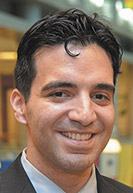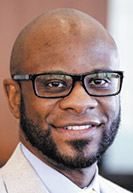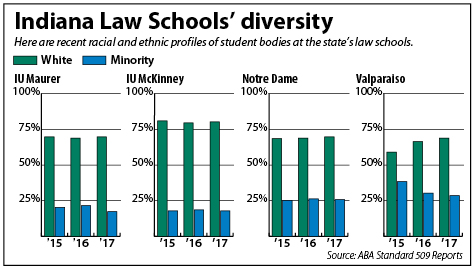Subscriber Benefit
As a subscriber you can listen to articles at work, in the car, or while you work out. Subscribe Now Griffey
GriffeyAllan Griffey, a third-year student at Indiana University Robert H. McKinney School of Law, knows from experience that being a minority can make law school more difficult.
The first in his family to attend college, Griffey overcame his own uncertainty of what to expect in law school by reaching out. He got involved in student activities at IU McKinney, now serving as president of the Hispanic Law Society, and he participated in the mentor program that paired him with a practicing attorney who offered advice and guidance.
Griffey also credited IU McKinney with creating a welcoming place for students from all racial and ethnic backgrounds. Still, when he looks around, he notices there are few students who look like him.
“Mainly you feel left out,” Griffey said, describing his experience. “You don’t really see or meet a lot of people with your heritage.”
 Parrish
ParrishThe lack of racial and ethnic diversity continues to frustrate law schools and the entire legal profession. As Austen Parrish, dean of Indiana University Maurer School of Law, explained, the question of how to improve minority enrollment has long been studied and remains a challenge for all levels of education starting in elementary school.
Within Indiana, the students at the four law schools remain primarily white and male, according to the American Bar Association’s 2017 Standard 509 reports. Valparaiso Law School led with minorities comprising 28.6 percent of its entire student body. Notre Dame Law School followed with minorities reaching 26.2 percent. IU McKinney and IU Maurer each reported a minority enrollment of 17.9 percent and 17.4 percent, respectively.
Parrish noted the number of applicants is increasing, but competition among law schools — particularly those in the Midwest — also is ratcheting up. He said the focus of recruitment is shifting to credentials. Law schools are trying to improve their stature and ranking by bringing in students who have high LSAT scores and grade point averages.
“High-performing students are in very high demand,” Parrish said.
Rethinking admissions
 Pusha
PushaInitially Rubin Pusha III planned to return to his more racially diverse home state and study at the University of Georgia School of Law. He arrived at IU to complete a master’s degree and had had to adjust to Midwestern culture.
However, hedging his bet, he also applied to IU Maurer and was impressed when he received a hand-written note from the law school’s then-assistant dean of admissions Frank Motley. At first reluctant, Pusha was convinced to stay in Bloomington by Motley’s assurances, comfort and support.
The Georgia native ended up being one of 11 African-Americans in a 1L class of more than 250 when he started at IU Maurer. Looking back, Pusha, now an associate at Barnes & Thornburg LLP in Indianapolis, enjoyed his law school experience.
Working at an AmLaw 100 firm, Pusha has seen an increase in minorities in the legal profession but believes improving the racial and ethnic mix will take a multi-step approach that includes law schools, law firms and businesses taking a holistic approach to evaluating applicants.
 Taylor
TaylorAaron Taylor, executive director at AccessLex Center for Legal Education Excellence, said law schools have instituted reforms, investing in academic support and being mindful of the cultural differences among students.
However, he said, minorities still only make up a small portion of enrollment and, as Griffey has experienced, diverse students often feel very isolated.
In an August 2017 article for the National Jurist, Taylor crunched the numbers and found that prospective minority students were not receiving as many admissions offers as their white counterparts. In 2015-2016, it took 2,273 applications from black students to yield 1,000 black law students while 1,389 applications were needed from white students to yield 1,000. Similarly, Hispanics had to file 1,754 applications and Asians 1,613 to each hit 1,000.
Law schools are creating a barrier, especially for minorities, Taylor said, by overemphasizing the importance of the LSAT score. The questions as to whether and why people of color tend to get lower scores on standardized tests would no longer be pertinent if law faculty “just use the LSAT appropriately,” he said, and take a more holistic look at the students who apply.
Yet, Taylor acknowledged changing admissions comes with the risk of dropping in law school rankings and of rousing the suspicions of the American Bar Association. Law schools could counter the negative reaction by collaborating in making changes together.
 Outside the classroom
Outside the classroom
Both Taylor and Parrish see ways for practicing lawyers and law firms to help legal education become more diverse. Attorneys can model the profession, encouraging high school students to study the law and mentoring law students. Also, firms can stop emphasizing the law school rankings in hiring decisions.
Griffey, who immigrated from Guatemala to Indiana when he was 6 years old, would have liked to have been able to talk to an attorney as he was applying to law school.
In fact, even though he had been accepted to IU McKinney, he was not certain he should attend. Griffey became more confident and moved forward with his legal studies after he participated in the Indiana Conference for Legal Education Opportunity (ICLEO) program. There he met other students who came from similar backgrounds as he did, and he learned study techniques that prepared him for the demands of law school.
His advice to other minority law students to help overcome the loneliness and succeed is simple. “I just tell them to get involved in everything the school has to offer,” he said.•
Please enable JavaScript to view this content.
